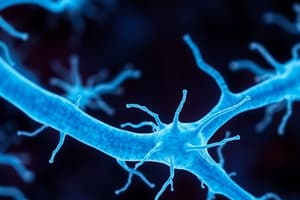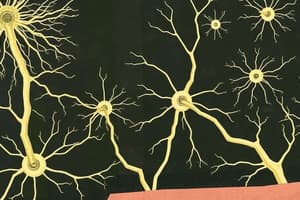Podcast
Questions and Answers
What is the primary function of the nervous system in the body?
What is the primary function of the nervous system in the body?
- To control and coordinate various functions (correct)
- To regulate body temperature
- To aid in digestion
- To produce neurotransmitters
Which part of the neuron receives signals?
Which part of the neuron receives signals?
- Cell body
- Terminal buttons
- Axon
- Dendrites (correct)
What is the gap between the terminal button of one neuron and the dendrite of another?
What is the gap between the terminal button of one neuron and the dendrite of another?
- Axon
- Neuron
- Dendrite
- Synapse (correct)
What is the response to a stimulus in a reflex action?
What is the response to a stimulus in a reflex action?
Which part of the brain is responsible for controlling movement?
Which part of the brain is responsible for controlling movement?
What is the difference between voluntary and involuntary actions?
What is the difference between voluntary and involuntary actions?
What is the function of the peripheral nervous system (PNS)?
What is the function of the peripheral nervous system (PNS)?
What is the role of the interneuron in a reflex action?
What is the role of the interneuron in a reflex action?
Flashcards are hidden until you start studying
Study Notes
Control and Coordination in Biology
Nervous System
- The nervous system is responsible for controlling and coordinating various functions in the body.
- It consists of:
- Central Nervous System (CNS): brain and spinal cord
- Peripheral Nervous System (PNS): nerves that connect CNS to the rest of the body
Neurons
- The building blocks of the nervous system
- Consist of:
- Dendrites: receive signals
- Cell body: also known as the soma
- Axon: carries signals away from the cell body
- Terminal buttons: release neurotransmitters
Synapse
- The gap between the terminal button of one neuron and the dendrite of another
- Neurotransmitters are released from the terminal button and bind to receptors on the dendrite, transmitting the signal
Reflex Action
- A rapid, automatic response to a stimulus
- Involves:
- Receptor: detects the stimulus
- Sensor neuron: transmits the signal to the CNS
- Interneuron: processes the information in the CNS
- Motor neuron: transmits the signal to the effector
- Effector: responds to the stimulus (e.g. muscle contraction)
Human Brain
- The control center of the body
- Divided into:
- Cerebrum: largest part, responsible for thinking, learning, and controlling movement
- Cerebellum: coordinates muscle movements and balance
- Brainstem: connects the cerebrum to the spinal cord, regulates basic functions like breathing and heart rate
Voluntary and Involuntary Actions
- Voluntary actions: controlled by the cerebrum, involve conscious thought (e.g. moving your arm)
- Involuntary actions: controlled by the autonomic nervous system, do not involve conscious thought (e.g. heart beating)
Nervous System
- Responsible for controlling and coordinating various functions in the body
- Consists of Central Nervous System (CNS) and Peripheral Nervous System (PNS)
Structure of Nervous System
- CNS: brain and spinal cord
- PNS: nerves that connect CNS to the rest of the body
Neurons
- Building blocks of the nervous system
- Consist of dendrites, cell body, axon, and terminal buttons
- Receive and transmit signals
Synapse
- Gap between terminal button of one neuron and dendrite of another
- Neurotransmitters released from terminal button bind to receptors on dendrite
Reflex Action
- Rapid, automatic response to a stimulus
- Involves receptor, sensor neuron, interneuron, motor neuron, and effector
Human Brain
- Control center of the body
- Divided into cerebrum, cerebellum, and brainstem
Brain Functions
- Cerebrum: thinking, learning, and controlling movement
- Cerebellum: coordinates muscle movements and balance
- Brainstem: regulates basic functions like breathing and heart rate
Voluntary and Involuntary Actions
- Voluntary actions: controlled by cerebrum, involve conscious thought
- Involuntary actions: controlled by autonomic nervous system, do not involve conscious thought
Studying That Suits You
Use AI to generate personalized quizzes and flashcards to suit your learning preferences.




